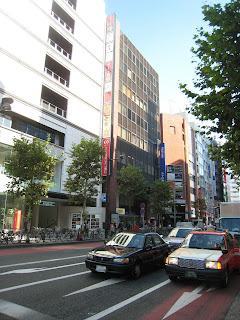大きな馬のお尻と軒を連ねる小さな宿屋。
What a bold composition!
Big buttocks of a horse and small inns lining along a street.
馬のわらじがかわいいです!
だけど、おっと!
馬さん落し物。
I like the straw shoes the horse is wearing.
But oops!
I see he has dropped something!
ここは新宿。
広重はちょうど新宿3丁目の交差点に立っています。
ということはもし広重が後ろを振り返ると、今なら…
This is Shinjuku.
Hiroshige is standing at the Shinjuku 3 Chome intersection.
So, if he was living now and if he turned back, he would be seeing ...
Isetan Department Store.
新宿は甲州街道一番目の宿場町。
もともと甲州街道の一番目の宿場町は高井戸でした。
でも日本橋から16キロも離れていて、不便だったそう。
そこで1698年に新しい宿場町が中間地点におかれました。
新しい宿場で「新宿」
なるほどそういうことでしたか。
初めて知りました。
Shinjuku was Shukuba (post town) along Koshu Kaido (road).
At first, the first Shukuba along the Koshu Kaido was in Takaido.
But it was 16 Km away from the starting point, Nihon-bashi, and was quite inconvenient.
So, in 1698, the new Shukuba was opened in between.
It was called Shinjuku because in Chinese characters "New Shuku" can be read "Shin-juku."
広重はちょうど新宿3丁目の交差点に立っています。
ということはもし広重が後ろを振り返ると、今なら…
This is Shinjuku.
Hiroshige is standing at the Shinjuku 3 Chome intersection.
So, if he was living now and if he turned back, he would be seeing ...
伊勢丹百貨店が見えているはず。
Isetan Department Store.
新宿は甲州街道一番目の宿場町。
もともと甲州街道の一番目の宿場町は高井戸でした。
でも日本橋から16キロも離れていて、不便だったそう。
そこで1698年に新しい宿場町が中間地点におかれました。
新しい宿場で「新宿」
なるほどそういうことでしたか。
初めて知りました。
Shinjuku was Shukuba (post town) along Koshu Kaido (road).
At first, the first Shukuba along the Koshu Kaido was in Takaido.
But it was 16 Km away from the starting point, Nihon-bashi, and was quite inconvenient.
So, in 1698, the new Shukuba was opened in between.
It was called Shinjuku because in Chinese characters "New Shuku" can be read "Shin-juku."
新宿は大変栄えたそうです。
交通の要所というだけでなく、歓楽街としてそこで働く飯盛女(遊女)の評判が高かったようです。
Shinjuku flourished very much.
Not only was the town important for transportation but also it had a high reputation for the beautiful women working in the inns.
交通の要所というだけでなく、歓楽街としてそこで働く飯盛女(遊女)の評判が高かったようです。
Shinjuku flourished very much.
Not only was the town important for transportation but also it had a high reputation for the beautiful women working in the inns.
当時流行った歌にこういうのがあったそうです。
「四谷新宿馬糞の中で、アヤメ咲くとはしおらしい」
ここでアヤメは遊女のこと。
私が読んだ本の中で、広重はこの歌を意識してこの絵を描いたのではないかと指摘されていました。
私もそう思います。
There was a popular funny song that went around in Hiroshige's time.
It went like this,
"Yotsuya Shinjuku
among horse droppings
beautiful iris bloom."
Iris here means prostitutes.
Some point out that Hiroshige painted this picture with this song in his mind.
I agree.
「四谷新宿馬糞の中で、アヤメ咲くとはしおらしい」
ここでアヤメは遊女のこと。
私が読んだ本の中で、広重はこの歌を意識してこの絵を描いたのではないかと指摘されていました。
私もそう思います。
There was a popular funny song that went around in Hiroshige's time.
It went like this,
"Yotsuya Shinjuku
among horse droppings
beautiful iris bloom."
Iris here means prostitutes.
Some point out that Hiroshige painted this picture with this song in his mind.
I agree.
今でも、新宿は栄えています。
Even today, Shinjuku is flourishing very much.
Even today, Shinjuku is flourishing very much.




No comments:
Post a Comment